Table of Contents
ToggleIntroduction
If you think of Shuttle nowadays, you might be visualizing small formfactor PCs or, even more likely, the massively successful XPC line of “cube PCs”, which were sold like mad, especially in the mid-2000s and are still available with recent platforms. But before the XPCs became their biggest success, Shuttle built some pretty good and well-received motherboards for about every consumer platform from Socket 3 and up.
While the AK31 was Shuttle's enthusiast offering with VIA's KT266 (later revisions: KT266A) chipset, the AK32 was their mainstream board. It is more upgrade-friendly with both DDR- and SDR memory slots being present and has a passively cooled northbridge, which is sufficient for stock operation and does not emit additional noise.
We'll see how it fares in this review. I am also very happy to have a Shuttle AK32A (KT266A) for comparison, so we can have a look if the updated chipset makes a notable difference in performance and / or stability. The review of the AK32A can be found here.
Gallery
Specifications and Features
Chipset:
- VIA KT266 (VT8366) Northbridge
- VIA VT8233 Southbridge
CPU Support (with latest BIOS):
- Athlon Thunderbird (ALL)
- Athlon XP Palomino (ALL)
- Athlon XP Thoroughbred (all FSB266 models up to 2600+)
- Athlon XP Thorton (all FSB266 models up to 2400+)
- Duron Spitfire (ALL)
- Duron Morgan (ALL)
- Duron Applebred (ALL)
Memory Support:
- 2 SDR DIMM slots
- 2 DDR DIMM slots
- Maximum total memory 2 GB
- no simultaneous usage of SDR and DDR memory
Expansion Slots:
- 1x AGP slot (1,5 / 3,3V) up to 4x
- 5x PCI slots
Connectors (internal):
- 2x IDE (UDMA100)
- 1x Floppy
- 4x USB 1.1
- 3x 3-pin fan connectors total (1x CPU, 2x chassis)
Connectors (external):
- 2x PS/2
- 2x COM/RS-232
- 1x Parallel Port
- 2x USB 1.1
- 3x 3,5" Audio Jacks (Line-Out, Line-In, Mic)
- Gameport
You might have noticed, that I didn't mention the audio chipset specifically, as I think far better solutions than the old onboard chipsets are readily available for little money. Very commonly recommended are the Creative Soundblaster Live! cards for example, which offer fantastic compatibility with our beloved old games and sound far better than any onboard solution of that era.
I also don't list (from a retro-gamers perspective) useless connectors and features like IR, Smartcard- or Wake-on-LAN connectors and so on.
Overclocking Features:
- Adjustable Multiplier (BIOS) from x5 to x14
- Adjustable FSB (BIOS) from 100 to 166 MHz in 1 MHz steps
- Adjustable VCore (BIOS) from +- 0,100 V in 0,025 V steps
The AK32 can be set up completely jumperless. If a new CPU is installed, the motherboard boots with FSB100, which can then be adjusted in 1 MHz steps from within the BIOS.
Documentation, Downloads, Drivers
Shuttle still hosts the original support pages from “back in the day” for their legacy products, which can be found here:
From there, you can select the “until 09/2004” link, to get to the oldest available iteration of shuttle's support portal. I must admit that it delivers the proper “retro feeling”, which is definitely a cool thing. All necessary downloads like the latest BIOS versions, as well as required flash tools, the manual and (outdated) drivers can be found there. CPU support lists, product specifications and a little FAQ section are also available there.
A download section for older BIOS versions for various legacy models can be found here:
https://download.shuttle.eu/Archive_2004/BIOS/
Another useful part of the support section is information on the different AK32 versions that were released. The following versions exist:
- AK32 “vanilla” V1.x
- AK32 V2.x aka AK322 aka AK32L
- AK32A
- AK32E
- AK32V
- AK32VN
While the AK32V(N) uses a smaller PCB, the other models use a very similar layout. The AK32 V2.x and the AK32A even look completely identical apart from some stickers and printings on the PCB. Shuttle helps you identify these with the following list (taken from the support site):
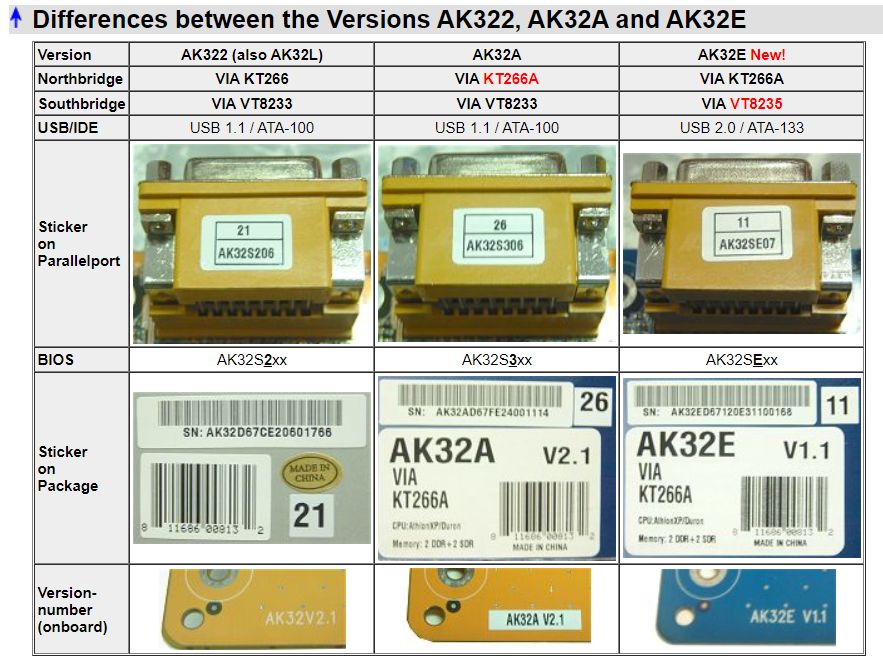
On the german support page is also a helpful table with an overview, that is missing in the english version:
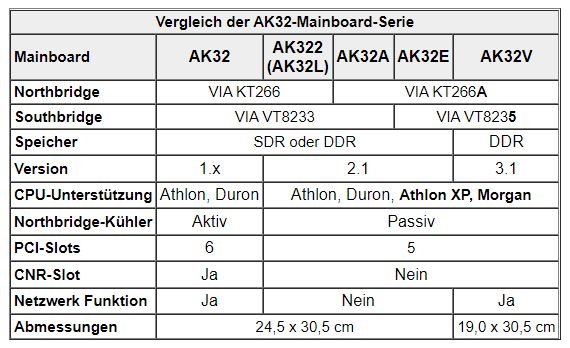
Design & Layout
The PCB Layout itself is pretty decent with some minor shortcomings. The best part of the layout is the lower right corner. Here we have the frontpanel connectors, the CMOS battery socket and the “Clear CMOS” jumper, a fan connector and the IDE- and floppy connectors, which sit nice and close to the edge of the PCB, together in one spot. Almost regardless of which expansion carts are installed, you will have all of these important things accessible even if the whole system is already completely assembled. Even the BIOS chip sits there, in case you need access to it.
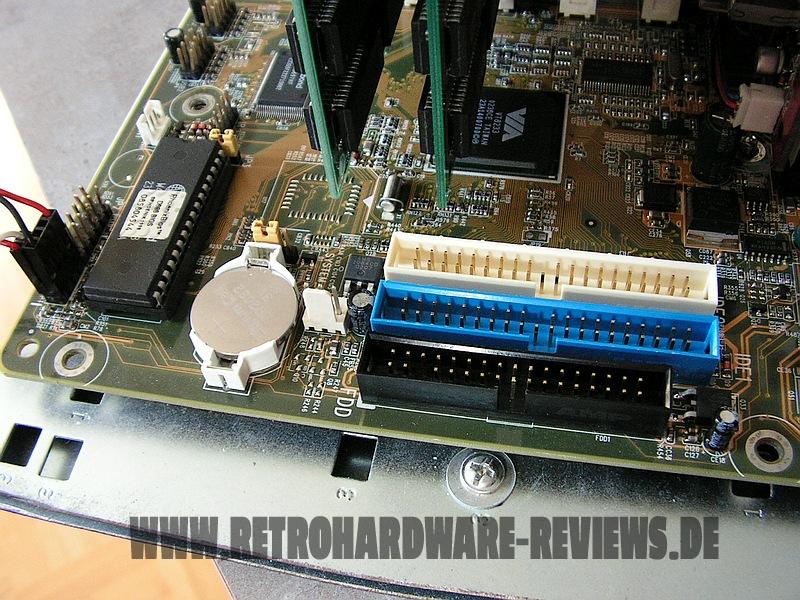
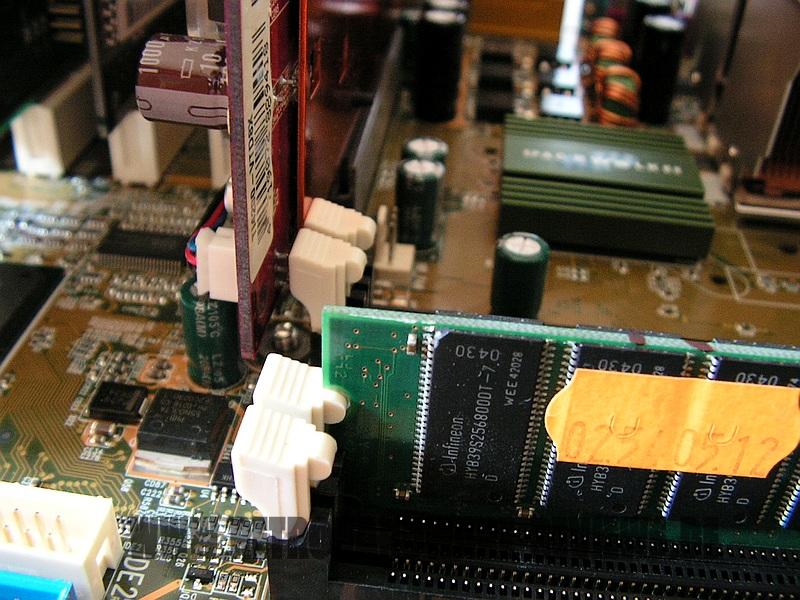
The memory slots sit tightly above the AGP port (which is also the case on many other boards), so that at least the DDR memory sticks cannot be removed or installed when your videocard is already in the system. If a long graphics card like the Voodoo 5 is installed, the SD-RAM slots are also blocked. With a Geforce 4 Ti 4200, they are accessible freely, but a Ti 4400 or 4600 would already be too long, as well.
The CPU socket is placed a fair bit lower than on many other boards, which should in theory reduce problems with larger CPU coolers. The space around the socket is also quite generous - apart from two nasty tall capacitors that are placed above the socket. These at least make the installation of the Alpha 8045 impossible - coolers with a smaller footprint on the bottom install without problems, however.
I tested the following eight CPU coolers regarding compatibility:
- Thermaltake Silent Boost K7
- Cooler Master HHC-001
- Swiftech MCX 370
- Alpha PAL 6035
- Alpha PAL 8045
- Smartcooler 60mm
- Arctic Cooling Copper Lite
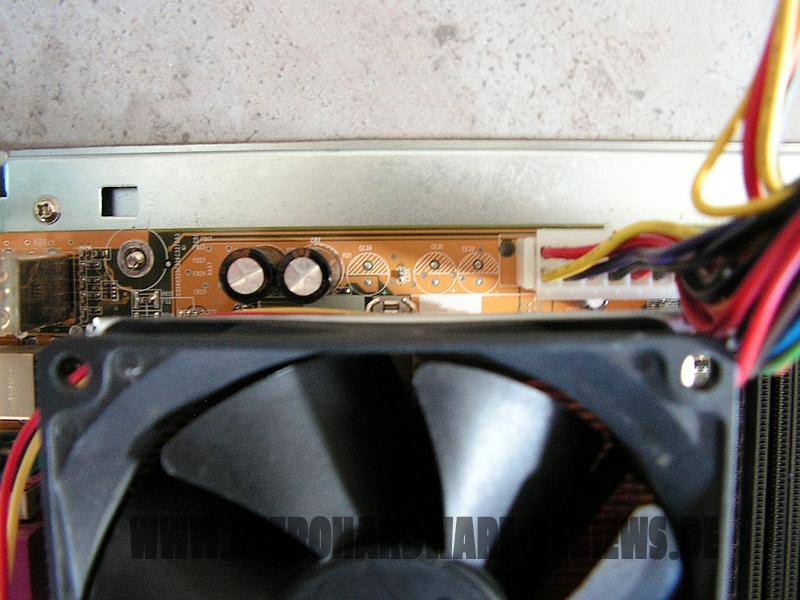
The Alpha 8045, as mentioned, does not fit, all others install fine. Even the lever of the Cooler Master HHC-001 does only reach a tiny bit over the PCB (even less than the picture suggests).
The ATX power cable connector is placed well on the upper edge of the board, which ensures that the power cable can be kept away from areas that need good airflow. Another plus is the inclusion of two 3-pin casefan connectors, which are located in good spots for connecting a front- and a rear fan.
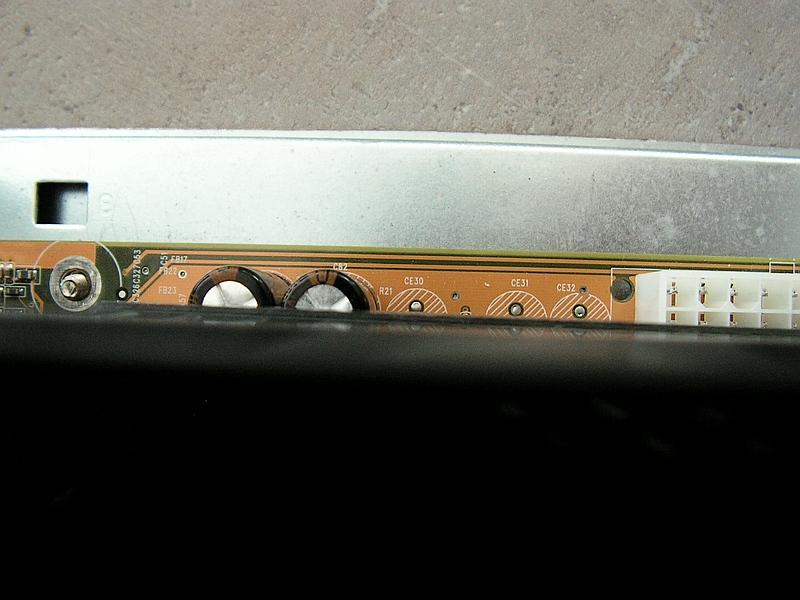
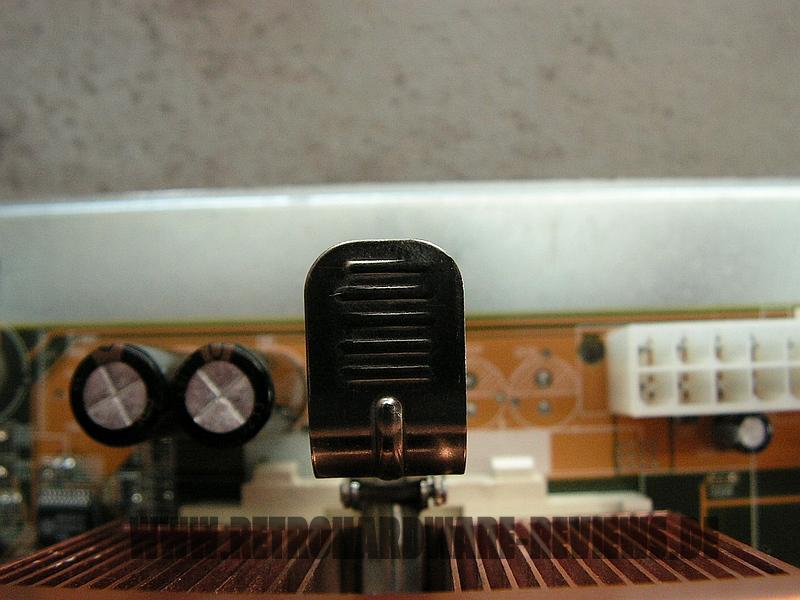
The thing I don't understand however, is the exclusion of another PCI slot. The space beneath the fifth PCI slot is completely unused (apart from some imprints). So either all expansion slots could have been moved further down to “unblock” the memory slots with a videocard installed, or a sixth PCI slot could have been included (as was the case with the AK32 v1.x by the way).
Test-System and Parts
Baseline Setup:
- CPU: AMD Athlon Thunderbird 1200C (FSB133)
Because I want to compare 1st Gen Socket A mainboards to their DDR follow-ups I have to use a CPU, which is available in FSB100 and FSB133 versions with the same clockspeed. Since I sadly don't have a Thunderbird 1400 B at my disposal, I will use the Thunderbird 1200 for my reviews and comparisons of these boards, which I have in the “B” (FSB100) and “C” (FSB133) version.
- RAM (DDR): 1x Corsair CMX512-3200C2 (XMS3202v4.2) = 512MB PC400 CL2
This Corsair XMS stick should allow the tightest timings at 266 MHz DDR and its size of 512MB is the perfect choice for Windows 98SE.
- 1x Kingston Value 512 MB PC133 CL2 (7ns Infineon Chips)
Since the AK32 did not accept my usual “Infineon 3rd" 512MB stick, that I normally use for testing boards that require SD-RAM memory, I used this one which is equally capable.
- VGA: MSI Geforce 4 TI4200-VTD8X
To remove any GPU bottleneck for testing, I chose a Geforce 4 Ti as the primary graphics card for my test setups. The Geforce 4 Ti series are also known to pull a lot of power from the AGP port, so that possible problems in that department can also be revealed. It is also somewhat period correct and a good match for a high performance retro-machine that should be able to run late Windows 98SE games without any issues.
- VGA2: 3dfx Voodoo 5 5500 AGP
Many people consider the Voodoo 5 5500 the perfect card for (Win9x-) retro gaming. The Voodoo 5 benefits from a beefy setup, so a powerful Athlon Thunderbird or early Athlon XP is the perfect match for this card.
- Audio: Creative Soundblaster Live! (SB0060)
Creative's Soundblaster Live! can be found in many retro-machines. It offers great sound, perfect Win98SE compatibility and is still widely available for reasonable money. It was also known to cause problems with VIA-based 686B southbridges using old BIOS revisions and VIA chipset drivers. All this should be history at this point, but double checking on pontentially affected mainboards is still not a bad thing to do.
- LAN: 3Com Etherlink XL PCI
Just a good, reliable choice for networking. All legacy Windows versions all the way up from Win95 have built-in drivers for it, which is also a huge “plus”.
- HDD: Western Digital WD200BB (20GB 7200RPM)
No special intention behind this drive, it is just “there” and still works fine.
Additional Hardware for certain Tests:
- Silicon Image Sil3512 SATA Controller & Samsung PM871 128GB SSD
These two will help me measure the PCI bandwidth.
- Western Digital WD5000AAKB (500GB 7200RPM)
This drive will tell us, how big we can go with the onboard IDE connectors and how the performance is like. - 2x Voodoo 2 12MB (SLI)
A pair of Voodoo 2s is a must have for any retro-machine, that doesn't feature a 3dfx card as the primary VGA solution. They offer compatibility to older Glide games and can be used with any more powerful primary graphics card. It is an important thing to know, how well these perform and if there are differences between all the available Socket A chipsets of that era or even between boards using the same chipset.
Drivers used:
- Chipset: VIA Hyperion 4in1 4.56v
- Geforce 4: nVidia Forceware 43.45
- Voodoo 5: Amigamerlin 2.9
- Voodoo 2: FastVoodoo 4.6
- SB Live!: Some driver from my archive, not shure 😉
- 3Com NIC: Windows 98SE preloaded driver
- SATA Controller: Some driver from my archive, not shure 😉
System Setup and Usage
As you may have read during this review, there are lots of different versions of the AK32 and they can easily be confused if you are not paying close attention. Well - it seems that someone has in fact confused my A32 V2.1 with a vanilla AK32 (V1.x). The BIOS version on my board matches the final version of the AK32 V1.x's BIOS:

I also have an option to disable the onboard LAN device for example, while V2.x boards do not even have this feature at all. I don't know how the person managed to do this, but I cannot flash the correct BIOS file now anymore:
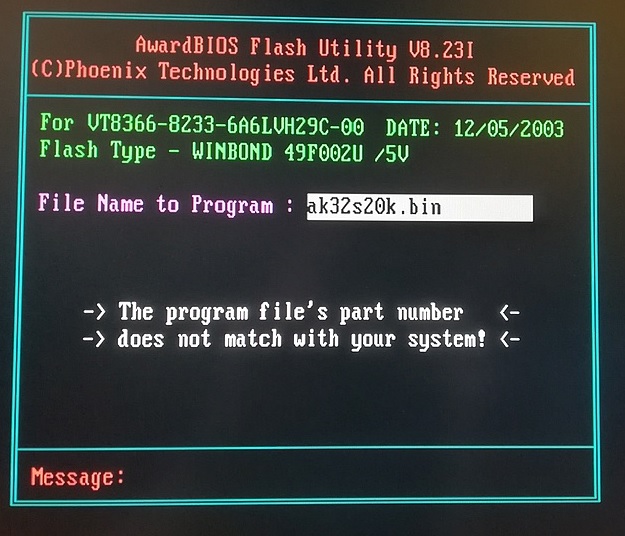
Since the board runs fine enough (for the most part, we'll get to that..), I'll just take it as given. But since the AK32 V1.x (which my BIOS version corresponds to) features six PCI slots and the V2.x boards have only five of them, perhaps the wrong BIOS explains the weird IRQ sharing going on on this board. Since there exists no documentation on which PCI slots share IRQs with each other and with onboard devices, I figured it with my proven “plug in the NIC and write down sharing” method. This is what I found out:
- PCI #1: shared with PCI #5, no sharing with onboard devices
- PCI #2: shared with onboard Audio
- PCI #3: shared with USB
- PCI #4: shared with AGP port
In the BIOS, you can also find out how the onboard devices are distributed over the four INT lines. According to this information, the AGP slot sits on the same primary INT line (INT-A) as the IDE controller, which is really uncommon. On all other boards I came accross so far, the AGP port has no sharing at all (which makes sense). Furthermore, the AGP port is shared with PCI #4, which is also somewhat “special”. In my opinion, the AGP port should always share its primary INT line with PCI #1, since you always want to keep it free to have your videocard run cooler.
Based on what I found out regarding the PCI assignment, I decided to leave the SATA controller out of the system until the Vodooo 2 benches are complete and install it afterwards, when the two 3dfx cards are removed. So I disabled all unnecessary onboard components and started with the following setup:
- PCI #1: free
- PCI #2: SB Live!
- PCI #3: Voodoo 2
- PCI #4: Voodoo 2
- PCI #5: 3Com NIC
Like always, I configured the BIOS to best possible performance, including all available memory timings. In case of the AK32, there aren't exacly a great number of memory settings available. After setting the “DRAM Timing” to Manual, you have a "generous" two settings at your disposal, which are Cycle Length and Bank Interleaving.
If DDR memory is installed, you can also configure the Command Rate (1T / 2T) as a third setting. I set the Cycle Length to “2” and Bank Interleaving to “4 Bank” which translates to the memory timings of CL2 2-2-6 (for DDR as well as SDR RAM). The 1T Command Rate was not stable, so I set it to 2T while using DDR RAM.
I completed all benchmarks using the above mentioned setup with DDR RAM and the Geforce 4 installed and did not experience any problems. I then wanted to bench the SSD connected to my SATA controller to measure the PCI bandwith. With the Voodoo 2 cards removed, I installed the controller into PCI #3. In this slot, the controller did not work at all. The controller's BIOS did not even load and the system got stuck on the POST screen.
After swapping PCI slots with the 3Com NIC, I got somewhat further but the system got stuck again - this time, it stopped with a blinking cursor during the Windows boot process. After a reset, however, it bootet up and I was able to install the driver and run the ATTO storage benchmark. The performance was shockingly low, so I removed all other PCI cards and redid the test - this bettered the results by around 2 MB/s but stayed extremely bad.
Before the Voodoo 5 benches, I wanted to redo the Geforce 4 and Voodoo 2 benchmarks using SDR memory, so I shut down the system (, removed the videocard... 😉 ), swapped the memory stick for my usual 512 MB “Infineon 3rd” PC133 SDR stick and... got no POST, but a repeated, single long beep. After two additional attempts I reset the BIOS and got a POST right away. But unfortunately my standard SDR stick got detected with a size of only 32MB, so I installed a 512 MB Kingston Value SDR stick, which was then detected fine. After reconfiguring the BIOS, all benchmarks completed without further unwanted events.
The next day I tried to start the system to remove the drivers for the Geforce and Voodoo 2 cards and install the Voodoo 5 afterwards for further testing. However, I was greeted with this error message during the boot process:

I tried slower memory timings and even loading the BIOS defaults, but Windows just died overnight. After re-imaging the installation, I configured the BIOS to what I had it at the day before and was able to boot up and install the Voodoo 5 driver without issues. I decided to stress the system a little to make sure Windows didn't self-destroy because perhaps the memory timings are too tight or something. So I fired up three instances of Prime95 - one each with the settings “Blend”, “Small FFTs” and "Inplace large FFTs". After 20 minutes without errors I considered the system stable and moved on with the benchmarks, which all completed fine.
When I then swapped the SDR memory stick for the Corsair XMS DDR stick, I was pleased to get a POST right away after powering up the system, as opposed to when I replaced the DDR for the SDR stick. Probably it was just the particular memory stick the system did not “like”. Which is a sad result for such a late SDR compatible chipset in the first place, but.. yeah. Anyways - my joy did not last long, as I was presented with something I saw before:

As before, Windows was completely toast again. From shutting down. Great.
So - another re-image, another driver installation, another successful run of benchmarks.
Out of curiosity, I started the system again, after it was shut down after the last benchmark. Like a minute afterwards. Guess what:

It just seems to self-destroy after every cold boot now. Great feature. I don't know if it is the wrong BIOS, degradation (but then again - it was stable throughout all testing) or something else, but I can only work with what I have. And the problem was not there in the beginning, I had at least one or two successful cold boots in the beginning of my testing.
Benchmarks
Synthetic Measurements
Before we get into the 3DMark and gaming benchmarks, let's have a look at some theoretical numbers. These synthetic tests will exhibit the differences between the several chipsets and boards better than any game benchmark and provide us with "background information" that might be of use in understanding the timedemo results later.
Memory Performance: AIDA64 Cache & Memory Benchmark
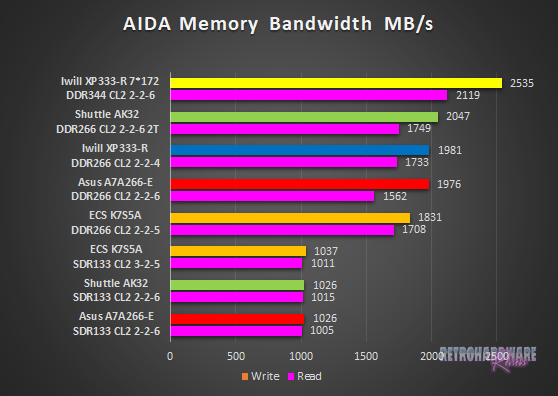
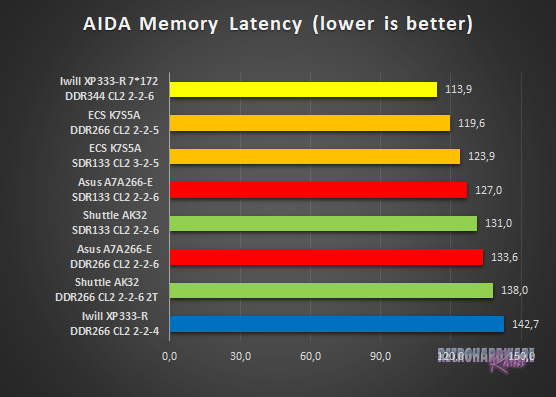
The AK32 starts with a very good result in the memory bandwidth test, showing the highest throughput of all boards in both read and write throughput, apart from the XP333-R with overclocked FSB. The measured bandwidth with SDR memory is around the same level of the other boards with the same type of memory.
It doesn't shine in terms of memory latency, however. Its measured latency is slightly above that of the A7A266-E for both memory types. Since the Asus board runs with a slightly raised FSB by default, it has a small advantage here. I think the boards would perform relatively similar in this test, if they were clocked exactly the same.
It is also interesting to note, that both, the AK32 as well as the A7A266-E, show lower latency with SDR memory than with DDR memory.
Application Performance: 7-Zip
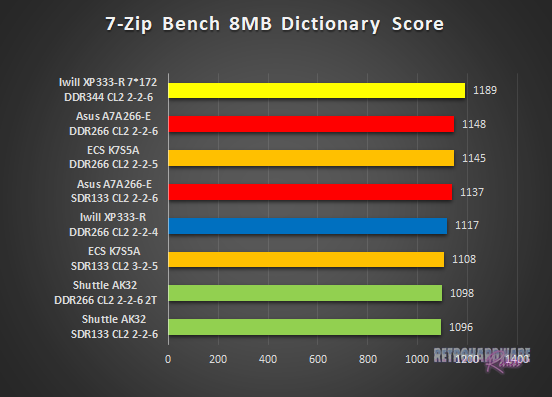
The performance in the 7-Zip benchmark is shockingly low. The AK32 takes last place, with almost identical results for both memory types. The result with DDR memory is especially disappointing, the other boards / chipsets show significantly better performance with the faster memory.
AGP Performance: Final Reality Benchmark
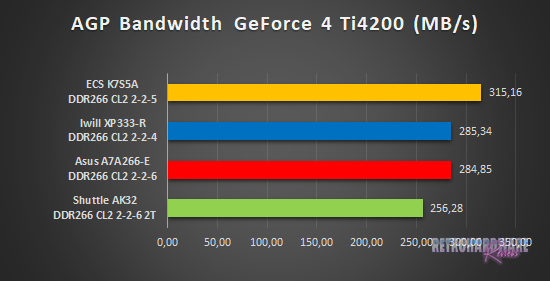
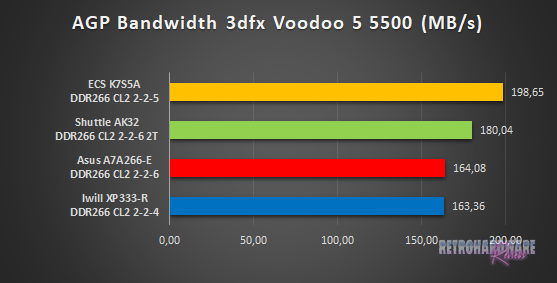
AGP bandwidth is not exactly great for both graphics cards, but it is still enough for second place with the Voodoo 5. However, this is more due to the very poor results of the ALi boards, than because of good performance. In combination with the GeForce 4 Ti, it ranks last in the bandwidth test.
AGP and PCI Performance: 3DMark 2000 and ATTO
3DMark 2000 as a whole is very focused on TnL and is by far not as interesting for retro-hardware comparisons as its predecessor. Its “High Polygon Count, 1 Light” test, however, is another good way to measure the AGP performance. In opposite to the Final Reality test, the general system performance is also somewhat of importance. The benchmark was executed with the Geforce 4 Ti installed.
To measure PCI performance, I installed a Windows 98SE compatible SATA controller with a Samsung PM871 128GB SSD connected into the system. For the bench, I chose 1024 to 4096 KB block size and picked the overall best values for the read and write throughput. This test will show, which maximum performance can be expected with fast storage options like SATA or SCSI and maybe gives a hint, if the chipset might be good for Voodoo 2 cards.
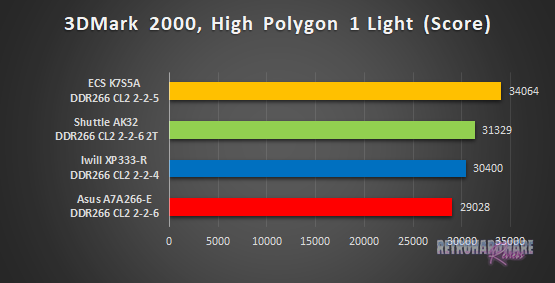
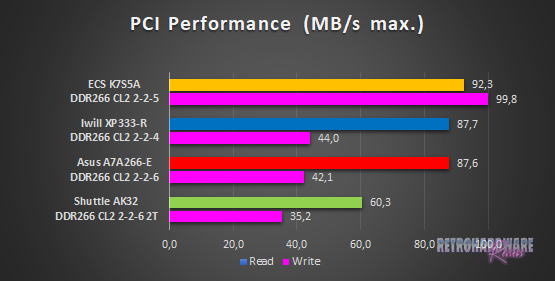
Things look better in 3DMark2000's sub-test. The Shuttle board ranks second, outperforming both of the ALi MAGiK-based boards. The K7S5A with the SiS735 chipset is still way ahead, though.
The PCI bandwidth of the board, however, is by far the worst of all boards. This is definitely not a good board for fast PCI-connected storage or other PCI bandwidth demanding expansion cards. We'll see later, if the low available bandwidth affects Voodoo 2 performance in the 3D tests.
Storage Performance: HDTach
To measure the performance of the board's IDE and (if available) onboard IDE RAID solutions' performance, I benched one of the latest and fastest IDE drives (the Hitachi Deskstar T7K500 500GB) with the HDTach benchmark. I also tried a much more “recent” drive (the Western Digital Blue Edition 500GB), which should be even faster in theory, but the Hitachi drive produced much better results in this test.
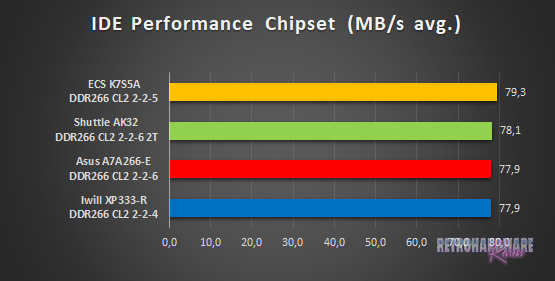
The IDE performance is very close between the boards and generally on a very high level. The AK32 takes second place, marginally ahead of the two ALi boards.
Gaming Benchmarks
Now that we got all the theoretical performance numbers, let's see how the contenders perform in 3D gaming benchmarks.
3D Performance: 3DMark99max
3DMark99max was released in early 1999 and comes without support for Hardware TnL. The maximum supported (hardware-) DirectX level is DX6. It is a great benchmark to reveal good overall system performance, as it rewards good memory bandwidth and latency more than the slight clockspeed advantage, that some boards have because of their factory-overclocked FSBs.
- Version: "latest"
- Settings: standard
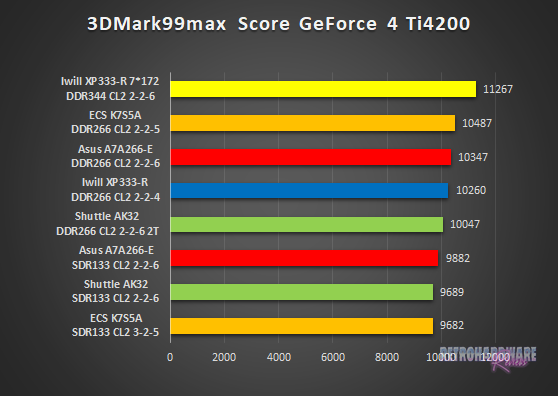
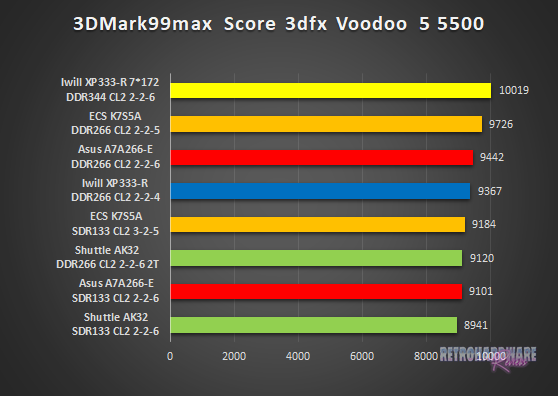
The AK32's 3DMark99max results look bad for the GeForce 4 Ti and even worse for the Voodoo 5. For the nVidia card, it is clearly the slowest board with DDR memory, but at least it doesn't get outperformed by any board using SDR memory.
This changes for the results with 3dfx' flagship card installed. The Shuttle board's result for DDR memory is only slightly better that that of the A7A266-E with SDR memory and it even gets surpassed by the K7S5A with the slower memory type.
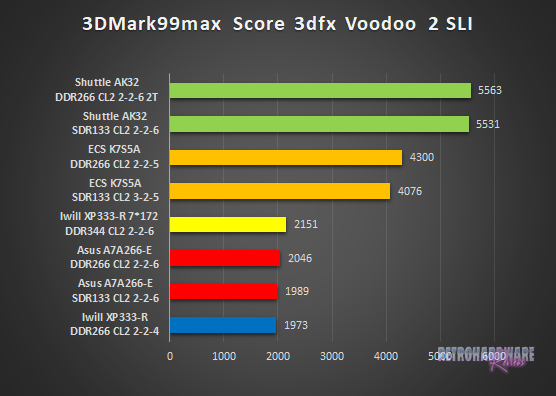
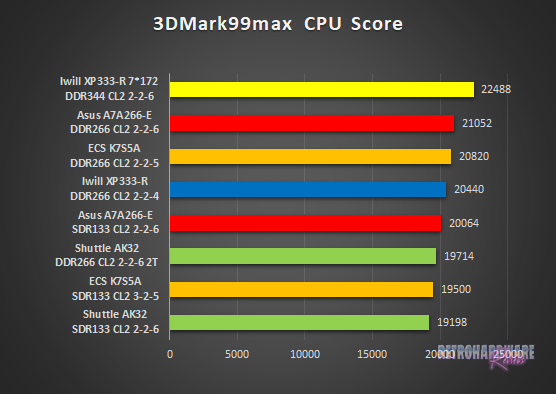
The same thing as for the Voodoo 5 results can be observed for the CPU score of the board, except that the SDR memory-equipped A7A266-E and K7S5A swap places.
Regardless of the relatively poor CPU score, the AK32 takes first and second place in the Voodoo 2 SLI run, with very similar performance for both memory types. All the other boards show really poor performance with the 3dfx cards and are far behind.
3D Performance: Unreal Tournament (UT99) Timedemo(s)
Unreal Tournament (UT99) was released in November 1999 and is notorious for its hunger for CPU power. I chose to use two different timedemos for comparison, of which the utbench.dem timedemo is heavily CPU bound and therefore qualifies to measure the general performance of the boards. The second timedemo benchmark.dem is as GPU limited as possible in this game. This will reveal, how much impact a faster board can still have in more GPU limited situations. This game is also perfect to show, on which chipsets and boards Voodoo 2 cards run best.
- Version: 4.36
- Settings: High, Min desired Framerate "0", Show Decals [x], Use Dynamic Lightning [x]
- Geforce: D3D
- Voodoo 2 and Voodoo 5: Glide
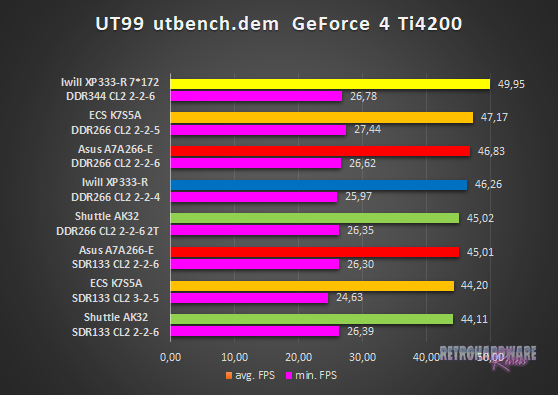
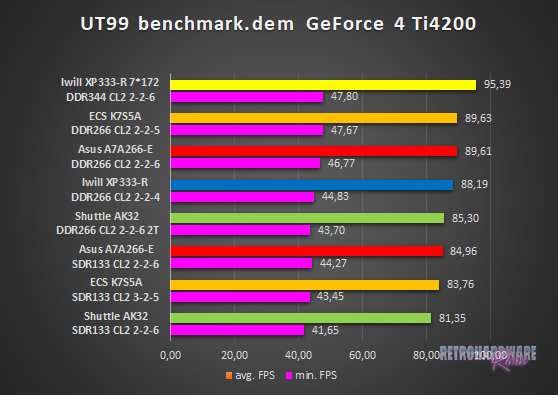
The AK32 is the slowest board in both timedemos and for both memory types (compared to the corresponding results for the same type of memory on the other boards).
Especially comparing all the DDR memory results, the AK32 seems visibly left behind. Its three competitors are relatively close to each other, the Shuttle board is always a bit behind the pack. It is much closer to the trailing A7A266-E with SDR memory, as to any of the DDR memory results of the other boards.
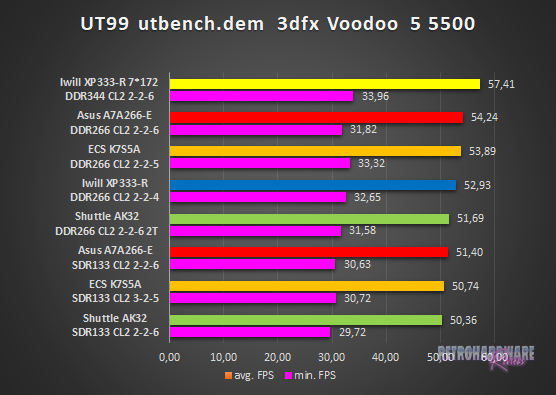
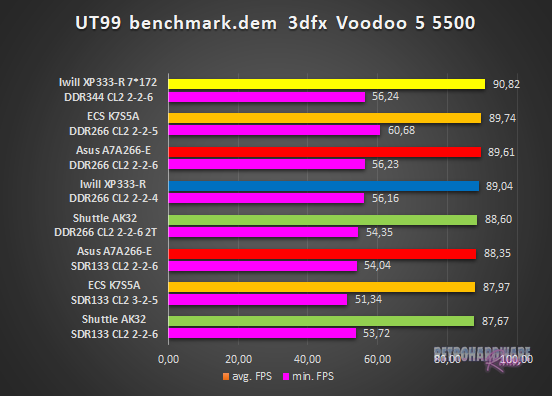
We see a similar trend and identical rankings for the AK32 in the Voodoo 5 run of the UT timedemos. The gap to the other DDR memory results is not that big this time, but the minimum FPS, especially in the benchmark.dem timedemo, are rather low in comparison and are more in the range of the SDR memory results.
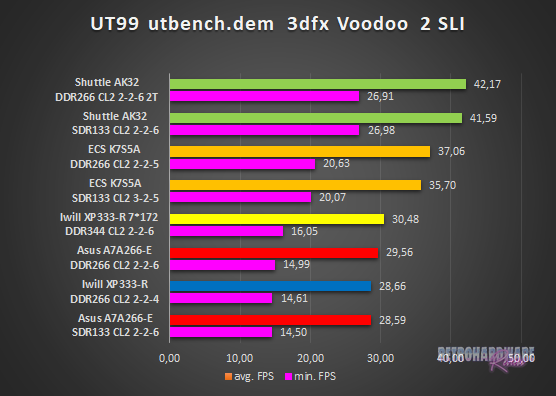
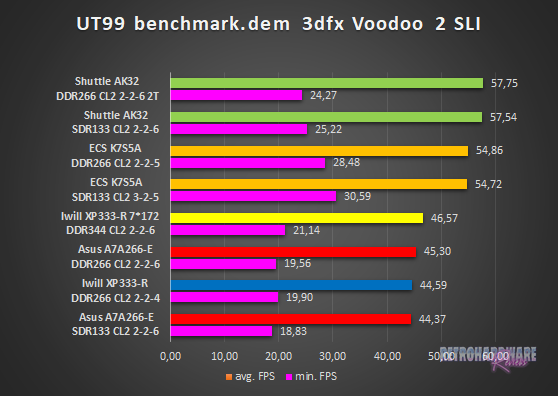
The AK32 takes first place in both timedemos with both memory types, as the performance issues of the other boards with the Voodoo 2 cards show up not only in 3DMark99max, but also here in UT. The performance of the AK32 with DDR and SDR memory is again quite similar, although the latter interestingly has a small advantage in minimum FPS.
3D Performance: Quake III Arena Timedemo
Quake 3 Arena was released shortly after Unreal Tournament, in December of 1999. It is known to reward fast memory latency and with its normal preset, it is completely CPU limited; at least for the GeForce 4 and the Voodoo 5. The Voodoo 2 SLI cards clearly limit the Athlon 1200 here, as the timedemo will show.
- Version: 1.32
- Settings: “Normal” Preset, only resolution changed to 1024x768x16
- Geforce 5 and Voodoo5: OpenGL
- Voodoo 2: “Voodoo” Renderer (miniGL)
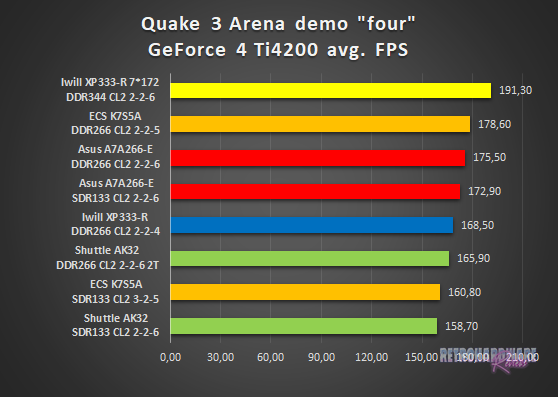
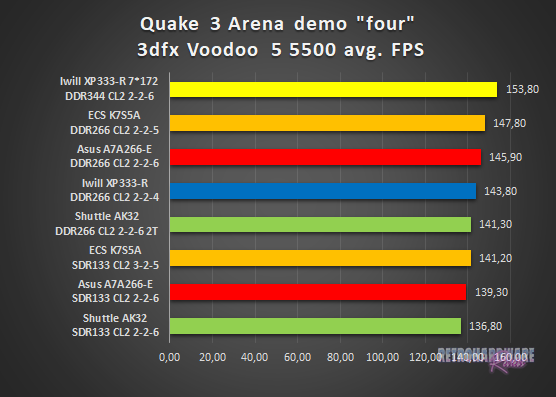
Quake III Arena is a return to the bottom of the list for the Shuttle board. The GeForce 4 Ti run looks particularly bad, as the AK32 is almost 13 FPS behind the first-placed Elitegroup board, ranking sixth for its DDR memory run and last with SDR memory.
In the Voodoo 5 run, the results are a lot closer and the AK32's performance is a little closer to the competition. Nevertheless, it achieves the lowest FPS of all boards when comparing the corresponding results for the same types of memory.
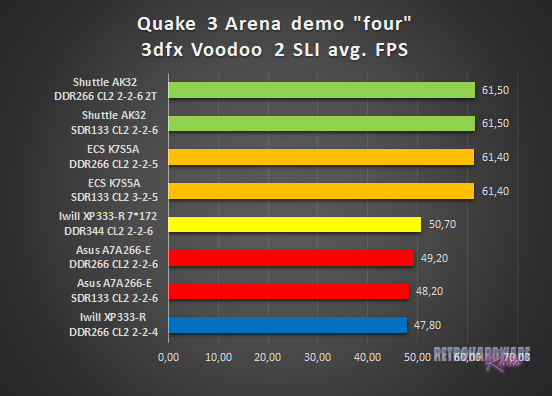
Both ALi boards again show poor performance, far worse than seen from the VIA and SiS chipset-based boards by Shuttle and ECS. The AK32 takes first place, slightly in front of the K7S5A. There is no difference in FPS between DDR and SDR memory on the AK32.
Summary & Rating
Shuttle AK32 (VIA KT266)
-
Layout
-
Features
-
Overclocking Options
-
Compatibility
-
Documentation & Support
-
Performance: GeForce 4 Ti 4200
-
Performance: Voodoo 5 5500
-
Performance: Voodoo 2 SLI
OVERALL
| Pros | Cons |
| + Great layout | – Capacitors above CPU vs. big coolers |
| + Great CPU support | – Abysmal PCI performance |
| + Awesome “retro” support section on old Shuttle site | – Poor overclocking and tweaking options |
| – Compatibility issues with SDR memory |






Pingback: Review: Shuttle AK32A - www.retrohardware-reviews.de